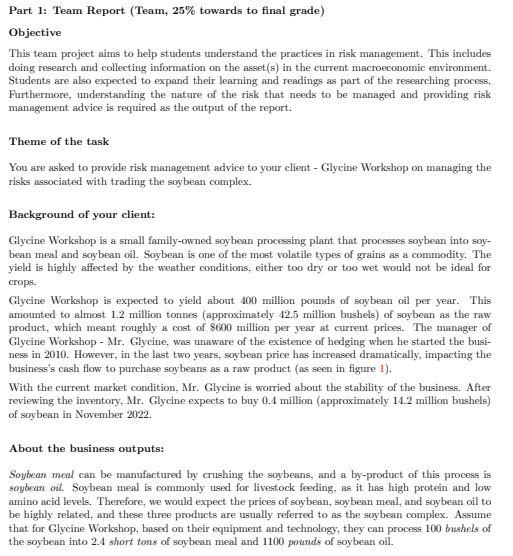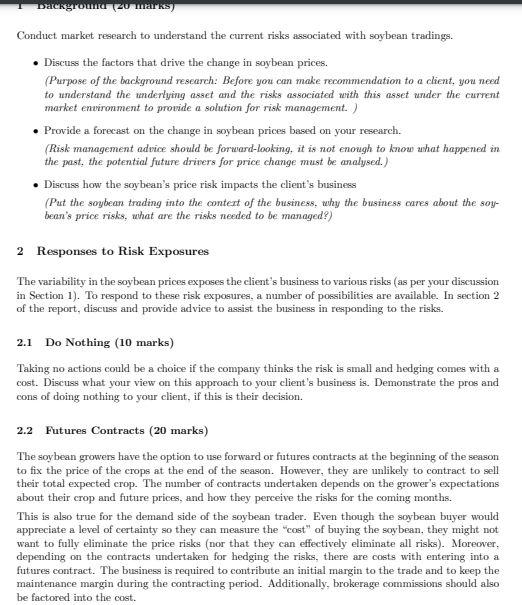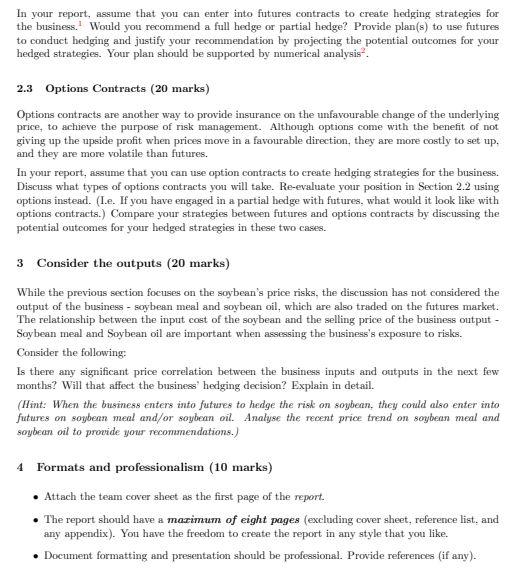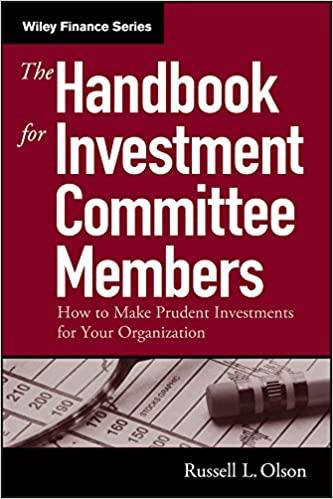Please complete part 2.2 and 2.3



Part 1: Team Report (Team, 25\% towards to final grade) Objective This team project aims to help students understand the practices in risk management. This includes doing research and collecting information on the asset(s) in the current macroeconomic environment. Students are also expected to expand their learning and readings as part of the researching process. Furthermore, understanding the nature of the risk that needs to be managed and providing risk management advice is required as the output of the report. Theme of the task You are asked to provide risk management advice to your client - Glycine Workshop on managing the risks nssociated with trading the soybean complex. Background of your client: Glycine Workshop is a small family-owned soybean processing plant that processes soybean into soybean meal and soybean oil. Soybean is one of the most volatile types of grains as a commocity. The yield is highly affected by the weather conditions, either too dry or too wet would not be ideal for crops. Glycine Workshop is expected to yield about 400 million pounds of soybean oil per year. This amounted to almost 1.2 million tonnes (approximately 42.5 million bushels) of soybean as the raw product, which meant roughly a cost of $600 million per year at current prices. The manager of Glycine Workshop - Mr. Glycine, was unaware of the existence of hedging when he started the business in 2010. However, in the last two years, soybean price has increased dramatically, impacting the business's cash flow to purchase soybeans as a raw product (as seen in figure 1). With the current market condition, Mr. Glycine is worried about the stability of the business. After reviewing the inventory. Mr. Glycine expects to buy 0.4 million (approximately 14.2 million bushels) of soybean in November 2022. About the business outputs: Soybean meal can be manufactured by crushing the soybeans, and a by-product of this process is soybean oul. Soybean meal is commonly used for livestock feeding, as it has high protein and low amino acid levels. Therefore, we would expect the prices of soybean, soybean meal, and soybean oil to be highly related, and these three products are usually referred to as the soybean complex. Assume that for Glycine Workshop, based on their equipment and technology, they can process 100 bushels of the soybean into 2.4 short tons of soybean meal and 1100 pounds of soybean oil. Conduct market research to understand the current risks associated with soybean tradings. - Discuss the factors that drive the change in soybean prices. (Purpose of the background research: Before you can make recommendation to a client, you need to understand the underlying asset and the risks associated with this asset under the current market environment to provide a solution for risk management.) - Provide a forecast on the change in soybean prices based on your research. Risk management advice should be forward-looking, it is not enough to know what happened in the past, the potential future drivers for price change must be analysed.) - Discuss how the soybean's price risk impacts the client's business (Put the soybean trading into the context of the business, why the business cares about the soybean's price risks, what are the risks needed to be managed?) 2 Responses to Risk Exposures The variability in the soybean prices exposes the client's business to various risks (as per your discussion in Section 1). To respond to these risk exposures, a number of possibilities are available. In section 2 of the report, discuss and provide advice to assist the business in responding to the risks. 2.1 Do Nothing (10 marks) Taking no actions could be a choice if the company thinks the risk is small and hedging comes with a cost. Discuss what your view on this approach to your client's business is. Demonstrate the pros and cons of doing nothing to your client, if this is their decision. 2.2 Futures Contracts (20 marks) The soybean growers have the option to use forward or futures contracts at the beginning of the season to fix the price of the crops at the end of the season. However, they are unlikely to contract to sell their total expected crop. The number of contracts undertaken depends on the grower's expectations about their crop and future prices, and how they perceive the risks for the coming months. This is also true for the demand side of the soybean trader. Even though the soybean buyer would appreciate a level of certainty so they can measure the "cost" of buying the soybean, they might not want to fully eliminate the price risks (nor that they can effectively eliminate all risks). Moreover, depending on the contracts undertaken for hedging the risks, there are costs with entering into a futures contract. The business is required to contribute an initial margin to the trade and to keep the maintenance margin during the contracting period. Additionally, brokerage commissions should also be factored into the cost. In your report, assume that you can enter into futures contracts to create hedging strategies for the business. 1 Would you recommend a full hedge or partial hedge? Provide plan(s) to use futures to conduct hedging and justify your recommendation by projecting the potential outcomes for your hedged strategies. Your plan should be supported by numerical analysis 2. 2.3 Options Contracts ( 20 marks) Options contracts are another way to provide insurance on the unfavourable change of the underlying price, to achieve the purpose of risk management. Although options come with the benefit of not. giving up the upside profit when prices move in a favourable direction, they are more costly to set up. and they are more volatile than futures. In your report, assume that you can use option contracts to create hedging strategies for the business. Discuss what types of options contracts you will take. Re-evaluate your position in Section 2.2 using options instead. (I.e. If you have engaged in a partial hedge with futures, what would it look like with options contracts.) Compare your strategies between futures and options contracts by discussing the potential outcomes for your hedged strategies in these two cases. 3 Consider the outputs (20 marks) While the previous section foeuses on the soybean's price risks, the discussion has not considered the output of the business - soybean meal and soybean oil, which are also traded on the futures market. The relationship between the input cost of the soybean and the selling price of the business output Soybean meal and Soybean oil are important when assessing the business's exposure to risks. Consider the following: Is there any significant price correlation between the business inputs and outputs in the next few months? Will that affect the business' hedging decision? Explain in detail. (Hint: When the business enters into futures to hedge the risk on soybean, they could also enter into futures on soybean meal and/or soybean oil. Analyse the recent price trend on soybean meal and soybean oil to provide your recommendations.) 4 Formats and professionalism (10 marks) - Attach the team cover sheet as the first page of the report. - The report should have a maximum of eight pages (excluding cover sheet, reference list, and any appendix). You have the freedom to create the report in any style that you like. - Document formatting and presentation should be professional. Provide references (if any). Part 1: Team Report (Team, 25\% towards to final grade) Objective This team project aims to help students understand the practices in risk management. This includes doing research and collecting information on the asset(s) in the current macroeconomic environment. Students are also expected to expand their learning and readings as part of the researching process. Furthermore, understanding the nature of the risk that needs to be managed and providing risk management advice is required as the output of the report. Theme of the task You are asked to provide risk management advice to your client - Glycine Workshop on managing the risks nssociated with trading the soybean complex. Background of your client: Glycine Workshop is a small family-owned soybean processing plant that processes soybean into soybean meal and soybean oil. Soybean is one of the most volatile types of grains as a commocity. The yield is highly affected by the weather conditions, either too dry or too wet would not be ideal for crops. Glycine Workshop is expected to yield about 400 million pounds of soybean oil per year. This amounted to almost 1.2 million tonnes (approximately 42.5 million bushels) of soybean as the raw product, which meant roughly a cost of $600 million per year at current prices. The manager of Glycine Workshop - Mr. Glycine, was unaware of the existence of hedging when he started the business in 2010. However, in the last two years, soybean price has increased dramatically, impacting the business's cash flow to purchase soybeans as a raw product (as seen in figure 1). With the current market condition, Mr. Glycine is worried about the stability of the business. After reviewing the inventory. Mr. Glycine expects to buy 0.4 million (approximately 14.2 million bushels) of soybean in November 2022. About the business outputs: Soybean meal can be manufactured by crushing the soybeans, and a by-product of this process is soybean oul. Soybean meal is commonly used for livestock feeding, as it has high protein and low amino acid levels. Therefore, we would expect the prices of soybean, soybean meal, and soybean oil to be highly related, and these three products are usually referred to as the soybean complex. Assume that for Glycine Workshop, based on their equipment and technology, they can process 100 bushels of the soybean into 2.4 short tons of soybean meal and 1100 pounds of soybean oil. Conduct market research to understand the current risks associated with soybean tradings. - Discuss the factors that drive the change in soybean prices. (Purpose of the background research: Before you can make recommendation to a client, you need to understand the underlying asset and the risks associated with this asset under the current market environment to provide a solution for risk management.) - Provide a forecast on the change in soybean prices based on your research. Risk management advice should be forward-looking, it is not enough to know what happened in the past, the potential future drivers for price change must be analysed.) - Discuss how the soybean's price risk impacts the client's business (Put the soybean trading into the context of the business, why the business cares about the soybean's price risks, what are the risks needed to be managed?) 2 Responses to Risk Exposures The variability in the soybean prices exposes the client's business to various risks (as per your discussion in Section 1). To respond to these risk exposures, a number of possibilities are available. In section 2 of the report, discuss and provide advice to assist the business in responding to the risks. 2.1 Do Nothing (10 marks) Taking no actions could be a choice if the company thinks the risk is small and hedging comes with a cost. Discuss what your view on this approach to your client's business is. Demonstrate the pros and cons of doing nothing to your client, if this is their decision. 2.2 Futures Contracts (20 marks) The soybean growers have the option to use forward or futures contracts at the beginning of the season to fix the price of the crops at the end of the season. However, they are unlikely to contract to sell their total expected crop. The number of contracts undertaken depends on the grower's expectations about their crop and future prices, and how they perceive the risks for the coming months. This is also true for the demand side of the soybean trader. Even though the soybean buyer would appreciate a level of certainty so they can measure the "cost" of buying the soybean, they might not want to fully eliminate the price risks (nor that they can effectively eliminate all risks). Moreover, depending on the contracts undertaken for hedging the risks, there are costs with entering into a futures contract. The business is required to contribute an initial margin to the trade and to keep the maintenance margin during the contracting period. Additionally, brokerage commissions should also be factored into the cost. In your report, assume that you can enter into futures contracts to create hedging strategies for the business. 1 Would you recommend a full hedge or partial hedge? Provide plan(s) to use futures to conduct hedging and justify your recommendation by projecting the potential outcomes for your hedged strategies. Your plan should be supported by numerical analysis 2. 2.3 Options Contracts ( 20 marks) Options contracts are another way to provide insurance on the unfavourable change of the underlying price, to achieve the purpose of risk management. Although options come with the benefit of not. giving up the upside profit when prices move in a favourable direction, they are more costly to set up. and they are more volatile than futures. In your report, assume that you can use option contracts to create hedging strategies for the business. Discuss what types of options contracts you will take. Re-evaluate your position in Section 2.2 using options instead. (I.e. If you have engaged in a partial hedge with futures, what would it look like with options contracts.) Compare your strategies between futures and options contracts by discussing the potential outcomes for your hedged strategies in these two cases. 3 Consider the outputs (20 marks) While the previous section foeuses on the soybean's price risks, the discussion has not considered the output of the business - soybean meal and soybean oil, which are also traded on the futures market. The relationship between the input cost of the soybean and the selling price of the business output Soybean meal and Soybean oil are important when assessing the business's exposure to risks. Consider the following: Is there any significant price correlation between the business inputs and outputs in the next few months? Will that affect the business' hedging decision? Explain in detail. (Hint: When the business enters into futures to hedge the risk on soybean, they could also enter into futures on soybean meal and/or soybean oil. Analyse the recent price trend on soybean meal and soybean oil to provide your recommendations.) 4 Formats and professionalism (10 marks) - Attach the team cover sheet as the first page of the report. - The report should have a maximum of eight pages (excluding cover sheet, reference list, and any appendix). You have the freedom to create the report in any style that you like. - Document formatting and presentation should be professional. Provide references (if any)









